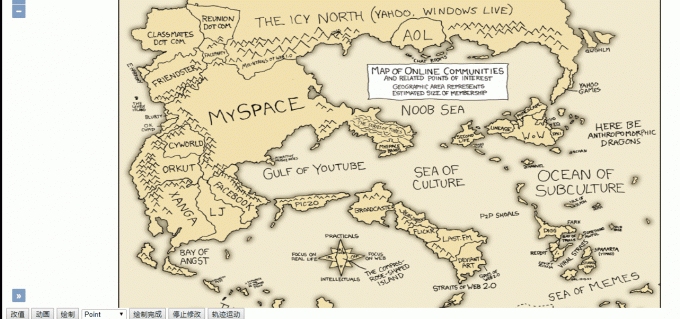|
本篇文章主要讲述的是在openlayer上实现路径运动,下面和小编一起去看看具体都是如何实现的吧,感兴趣的朋友可以看看。
一、需求分析客户需要的功能就是能在一张Gis图上实现小车根据路径进行移动,为什么一定要Gis呢(这是客户指定需求,无语一该)。并且客户还说底图要很容易更换,但他想要用Gis表现的却是室内的地理信息,我也没办法用baidu, 高德等现成的Gis接口。 针对上述需求,我没有去了解过多的web gis框架。因为客户对Gis的概念就是能放大,缩小,可以做路径规划等。所以我就选择ol,利用他的静态图片(选择这个是为满足客户灵活更新底图的需求)做Gis底图的功能来解决此问题。 二、效果展示
三、伪代码实现由于是技术验证代码, 有些杂乱,现只给出关键性代码。如有业务需要欢迎共同讨论。 3.1 实现路径的绘制此步骤还是相对简单的,主要用到Ol的Draw对象,代码哪下:
draw(type){
this.stopdraw();
this._draw = new Draw({
source: this.layer.getSource(),
type: type == 'Icon' ? 'Point' : type
});
this._draw.on('drawend', (event)=>{
if(type == 'LineString'){
this.traceLine = event.feature;
}
if(type != 'Icon') return;
let f = event.feature;
f.setStyle(new Style({
image: new Icon({
src: '/content/battery.gif'
}),
text: new Text({
text: 'new item',
fill: new Fill({
color: "red"
})
})
}));
f.type = 'battery';
});
this.map.addInteraction(this._draw);
this._snap = new Snap({source: this.layer.getSource()});
this.map.addInteraction(this._snap);
}
关键代码在于drawend事件的监听,如果是LineString情况,就将此feature放在一个共公变量,方便路径运行时使用。 3.2 分解路径数据此部分就是获取到3.1步骤的路径路径,然后进行解析,因为3.1上的linestring是多个线段的集合,但运动其本质就是改变图标的坐标,使其快速且连续的变化就形成了移动效果。所以这里有一个方法进行路径细分,代码如下:
cutTrace(){
let traceCroods = this.traceLine.getGeometry().getCoordinates();
let len = traceCroods.length;
let destCroods = [];
for(let i = 0; i < len - 1; ++i){
let bPoint = traceCroods[i];
let ePoint = traceCroods[i+1];
let bevelling = Math.sqrt(Math.pow(ePoint[0] - bPoint[0], 2)
+ Math.pow(ePoint[1] - bPoint[1], 2) );
let cosA = (ePoint[0] - bPoint[0]) / bevelling;
let sinA = (ePoint[1] - bPoint[1]) / bevelling;
let curStep = 0;
let step = 5;
destCroods.push(new Point([bPoint[0], bPoint[1]]));
do{
curStep++;
let nextPoint;
if(curStep * step >= bevelling){
nextPoint = new Point([ePoint[0], ePoint[1]]);
}else{
nextPoint = new Point([
cosA * curStep * step + bPoint[0]
,
sinA * curStep * step + bPoint[1]
]);
}
destCroods.push(nextPoint);
}while(curStep * step < bevelling);
}
return destCroods;
}
其中用到了一些数学上的三角函数和计算方法。此方法最终选一个根据步长计算后的坐标集合。 3.3 利用postcompose实现运动效果代码如下:
tracerun(){
if(!this.traceLine) return;
this.traceCroods = this.cutTrace();
this.now = new Date().getTime();
this.map.on('postcompose', this.moveFeature.bind(this));
this.map.render();
}
moveFeature(event){
let vCxt = event.vectorContext;
let fState = event.frameState;
let elapsedTime = fState.time - this.now;
let index = Math.round(300 * elapsedTime / 1000);
let len = this.traceCroods.length;
if(index >= len){
//stop
this.map.un('postcompose', this.moveFeature);
return;
}
let dx, dy, rotation;
if(this.traceCroods[index] && this.traceCroods[index + 1]){
let isRigth = false;
let bCrood = this.traceCroods[index].getCoordinates();
let eCrood = this.traceCroods[index + 1].getCoordinates();
if(bCrood[0] < eCrood[0]){
//左->右
isRigth = true
}
dx = bCrood[0] - eCrood[0];
dy = bCrood[1] - eCrood[1];
rotation = Math.atan2(dy,dx);
if(rotation > (Math.PI / 2)){
//修正
rotation = Math.PI - rotation;
}else if(rotation < -1 * (Math.PI / 2)){
rotation = -1 * Math.PI - rotation;
}else{
rotation = -rotation;
}
console.log(dx + ' ' + dy + ' ' + rotation);
let curPoint = this.traceCroods[index];
var anchor = new Feature(curPoint);
let style = new Style({
image: new Icon({
img: isRigth ? this.carRight : this.carImg,
imgSize: [32,32],
rotateWithView: false,
rotation: rotation
}),
text: new Text({
text: 'Car',
fill: new Fill({
color: 'red'
}),
offsetY: -20
})
});
vCxt.drawFeature(anchor, style);
//this.map.getView().setCenter(bCrood);
}
this.map.render();
}
此移动代码的是用ol的postcompose事件进行实现的,因为render方法执行完成后会触发postcompose事件,所以就代替了定时器的的实现方案。其中rotation根据两点坐标计算出移动图标的斜度、以及移动的方向等,更为影响的展示。 (责任编辑:yang) |

